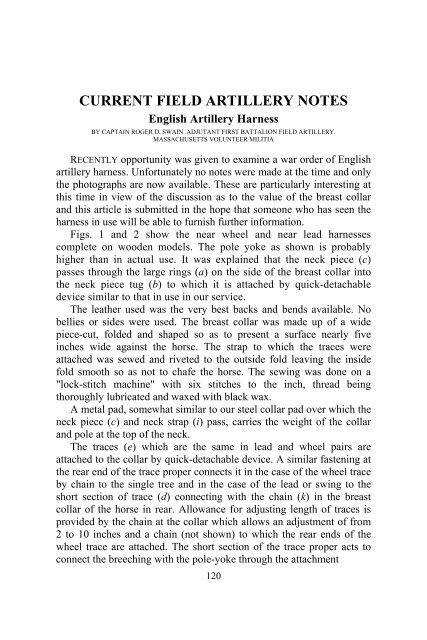the field artillery journal - Fort Sill - U.S. Army
the field artillery journal - Fort Sill - U.S. Army
the field artillery journal - Fort Sill - U.S. Army
Create successful ePaper yourself
Turn your PDF publications into a flip-book with our unique Google optimized e-Paper software.
CURRENT FIELD ARTILLERY NOTES<br />
English Artillery Harness<br />
BY CAPTAIN ROGER D. SWAIN. ADJUTANT FIRST BATTALION FIELD ARTILLERY.<br />
MASSACHUSETTS VOLUNTEER MILITIA<br />
RECENTLY opportunity was given to examine a war order of English<br />
<strong>artillery</strong> harness. Unfortunately no notes were made at <strong>the</strong> time and only<br />
<strong>the</strong> photographs are now available. These are particularly interesting at<br />
this time in view of <strong>the</strong> discussion as to <strong>the</strong> value of <strong>the</strong> breast collar<br />
and this article is submitted in <strong>the</strong> hope that someone who has seen <strong>the</strong><br />
harness in use will be able to furnish fur<strong>the</strong>r information.<br />
Figs. 1 and 2 show <strong>the</strong> near wheel and near lead harnesses<br />
complete on wooden models. The pole yoke as shown is probably<br />
higher than in actual use. It was explained that <strong>the</strong> neck piece (c)<br />
passes through <strong>the</strong> large rings (a) on <strong>the</strong> side of <strong>the</strong> breast collar into<br />
<strong>the</strong> neck piece tug (b) to which it is attached by quick-detachable<br />
device similar to that in use in our service.<br />
The lea<strong>the</strong>r used was <strong>the</strong> very best backs and bends available. No<br />
bellies or sides were used. The breast collar was made up of a wide<br />
piece-cut, folded and shaped so as to present a surface nearly five<br />
inches wide against <strong>the</strong> horse. The strap to which <strong>the</strong> traces were<br />
attached was sewed and riveted to <strong>the</strong> outside fold leaving <strong>the</strong> inside<br />
fold smooth so as not to chafe <strong>the</strong> horse. The sewing was done on a<br />
"lock-stitch machine" with six stitches to <strong>the</strong> inch, thread being<br />
thoroughly lubricated and waxed with black wax.<br />
A metal pad, somewhat similar to our steel collar pad over which <strong>the</strong><br />
neck piece (c) and neck strap (i) pass, carries <strong>the</strong> weight of <strong>the</strong> collar<br />
and pole at <strong>the</strong> top of <strong>the</strong> neck.<br />
The traces (e) which are <strong>the</strong> same in lead and wheel pairs are<br />
attached to <strong>the</strong> collar by quick-detachable device. A similar fastening at<br />
<strong>the</strong> rear end of <strong>the</strong> trace proper connects it in <strong>the</strong> case of <strong>the</strong> wheel trace<br />
by chain to <strong>the</strong> single tree and in <strong>the</strong> case of <strong>the</strong> lead or swing to <strong>the</strong><br />
short section of trace (d) connecting with <strong>the</strong> chain (k) in <strong>the</strong> breast<br />
collar of <strong>the</strong> horse in rear. Allowance for adjusting length of traces is<br />
provided by <strong>the</strong> chain at <strong>the</strong> collar which allows an adjustment of from<br />
2 to 10 inches and a chain (not shown) to which <strong>the</strong> rear ends of <strong>the</strong><br />
wheel trace are attached. The short section of <strong>the</strong> trace proper acts to<br />
connect <strong>the</strong> breeching with <strong>the</strong> pole-yoke through <strong>the</strong> attachment<br />
120

















